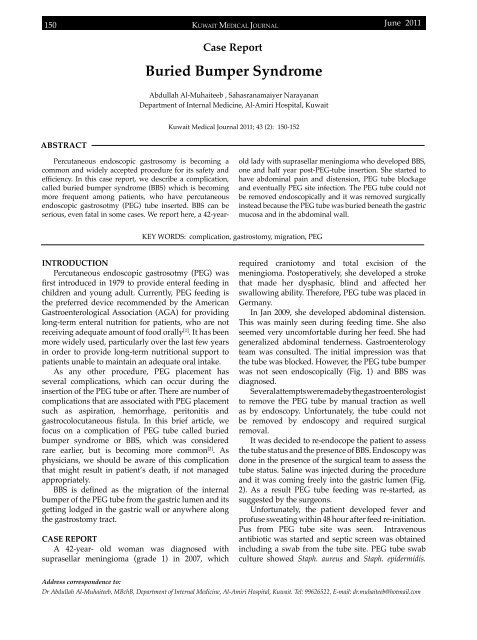Vol 43 # 2 June 2011 - Kma.org.kw
Vol 43 # 2 June 2011 - Kma.org.kw
Vol 43 # 2 June 2011 - Kma.org.kw
Create successful ePaper yourself
Turn your PDF publications into a flip-book with our unique Google optimized e-Paper software.
150<br />
KUWAIT MEDICAL JOURNAL<br />
<strong>June</strong> <strong>2011</strong><br />
Case Report<br />
Buried Bumper Syndrome<br />
Abdullah Al-Muhaiteeb , Sahasranamaiyer Narayanan<br />
Department of Internal Medicine, Al-Amiri Hospital, Kuwait<br />
Kuwait Medical Journal <strong>2011</strong>; <strong>43</strong> (2): 150-152<br />
ABSTRACT<br />
Percutaneous endoscopic gastrosomy is becoming a<br />
common and widely accepted procedure for its safety and<br />
efficiency. In this case report, we describe a complication,<br />
called buried bumper syndrome (BBS) which is becoming<br />
more frequent among patients, who have percutaneous<br />
endoscopic gastrosotmy (PEG) tube inserted. BBS can be<br />
serious, even fatal in some cases. We report here, a 42-yearold<br />
lady with suprasellar meningioma who developed BBS,<br />
one and half year post-PEG-tube insertion. She started to<br />
have abdominal pain and distension, PEG tube blockage<br />
and eventually PEG site infection. The PEG tube could not<br />
be removed endoscopically and it was removed surgically<br />
instead because the PEG tube was buried beneath the gastric<br />
mucosa and in the abdominal wall.<br />
KEY WORDS: complication, gastrostomy, migration, PEG<br />
INTRODUCTION<br />
Percutaneous endoscopic gastrosotmy (PEG) was<br />
first introduced in 1979 to provide enteral feeding in<br />
children and young adult. Currently, PEG feeding is<br />
the preferred device recommended by the American<br />
Gastroenterological Association (AGA) for providing<br />
long-term enteral nutrition for patients, who are not<br />
receiving adequate amount of food orally [1] . It has been<br />
more widely used, particularly over the last few years<br />
in order to provide long-term nutritional support to<br />
patients unable to maintain an adequate oral intake.<br />
As any other procedure, PEG placement has<br />
several complications, which can occur during the<br />
insertion of the PEG tube or after. There are number of<br />
complications that are associated with PEG placement<br />
such as aspiration, hemorrhage, peritonitis and<br />
gastrocolocutaneous fistula. In this brief article, we<br />
focus on a complication of PEG tube called buried<br />
bumper syndrome or BBS, which was considered<br />
rare earlier, but is becoming more common [2] . As<br />
physicians, we should be aware of this complication<br />
that might result in patient’s death, if not managed<br />
appropriately.<br />
BBS is defined as the migration of the internal<br />
bumper of the PEG tube from the gastric lumen and its<br />
getting lodged in the gastric wall or anywhere along<br />
the gastrostomy tract.<br />
CASE REPORT<br />
A 42-year- old woman was diagnosed with<br />
suprasellar meningioma (grade 1) in 2007, which<br />
required craniotomy and total excision of the<br />
meningioma. Postoperatively, she developed a stroke<br />
that made her dysphasic, blind and affected her<br />
swallowing ability. Therefore, PEG tube was placed in<br />
Germany.<br />
In Jan 2009, she developed abdominal distension.<br />
This was mainly seen during feeding time. She also<br />
seemed very uncomfortable during her feed. She had<br />
generalized abdominal tenderness. Gastroenterology<br />
team was consulted. The initial impression was that<br />
the tube was blocked. However, the PEG tube bumper<br />
was not seen endoscopically (Fig. 1) and BBS was<br />
diagnosed.<br />
Several attempts were made by the gastroenterologist<br />
to remove the PEG tube by manual traction as well<br />
as by endoscopy. Unfortunately, the tube could not<br />
be removed by endoscopy and required surgical<br />
removal.<br />
It was decided to re-endocope the patient to assess<br />
the tube status and the presence of BBS. Endoscopy was<br />
done in the presence of the surgical team to assess the<br />
tube status. Saline was injected during the procedure<br />
and it was coming freely into the gastric lumen (Fig.<br />
2). As a result PEG tube feeding was re-started, as<br />
suggested by the surgeons.<br />
Unfortunately, the patient developed fever and<br />
profuse sweating within 48 hour after feed re-initiation.<br />
Pus from PEG tube site was seen. Intravenous<br />
antibiotic was started and septic screen was obtained<br />
including a swab from the tube site. PEG tube swab<br />
culture showed Staph. aureus and Staph. epidermidis.<br />
Address correspondence to:<br />
Dr Abdullah Al-Muhaiteeb, MBchB, Department of Internal Medicine, Al-Amiri Hospital, Kuwait. Tel: 99626522, E-mail: dr.muhaiteeb@hotmail.com
















